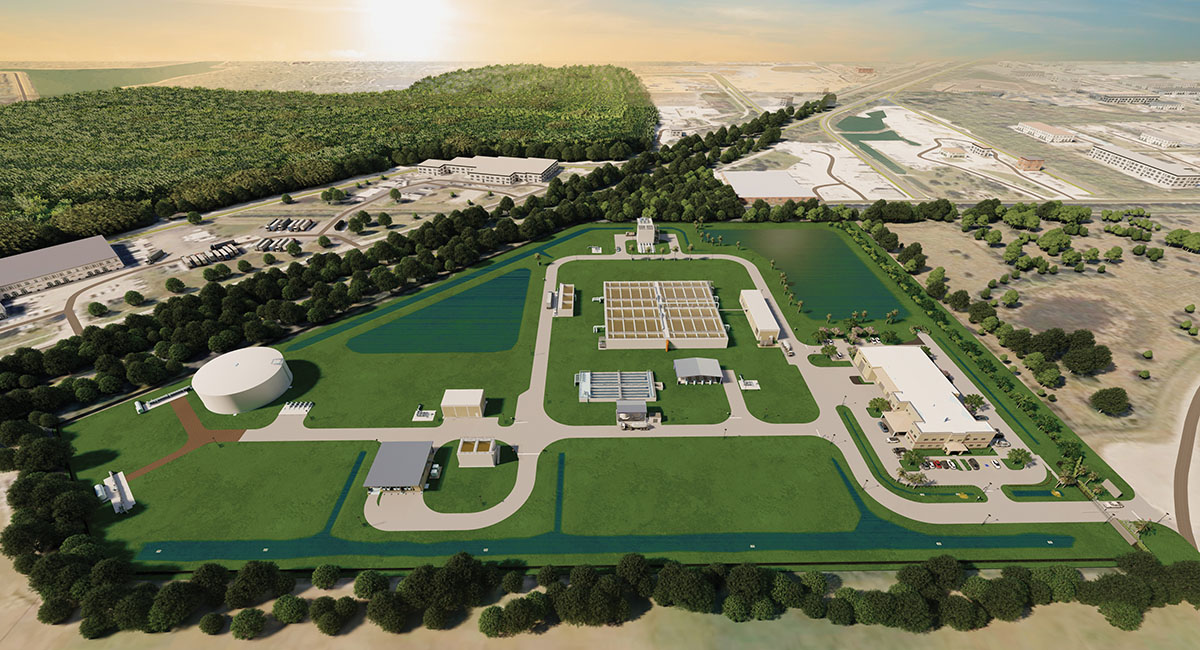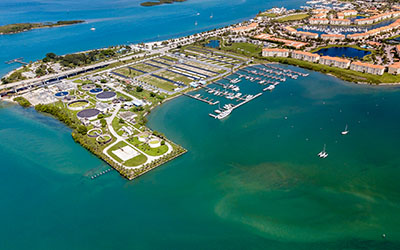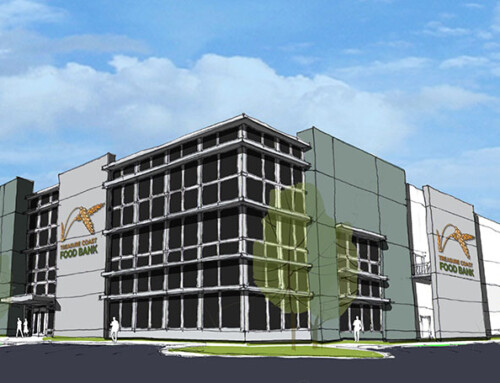Water works

Fort Pierce Utilities Authority is in the process of constructing a new Wastewater Treatment Facility near Treasure Coast Energy Center, a natural gas plant owned by Florida Municipal Power Agency. Reclaimed water from the treatment plant will be used to cool the natural gas plant. The new treatment facility on Energy Lane is planned to be fully operational by 2027 at which time the current facility on South Beach will be decommissioned. MAIN STREET FORT PIERCE
Vero, Fort Pierce moving water treatment plants
BY PATTIE DURHAM
It is, in essence, the tale of two Florida cities. Each built and prospering along the waterway connecting them with towns up and down the coast and places beyond. As the population of the towns grew, water and sewer systems were needed for residents. During the 20th century, facilities were constructed in the towns of Fort Pierce and Vero Beach along the waterway.
Now, each of the cities is planning to move its wastewater treatment facilities to a more western location, driven by population growth and the need for increased capacity and the ecological concerns for the Indian River Lagoon.
In Fort Pierce, the city’s facilities were constructed on South Hutchinson Island after the U.S. Navy closed down its World War II frogman training program. The Navy had constructed a sewer and water system for its personnel. When the war ended and the system was no longer in use by the Navy, it eventually reverted to the city. The current wastewater treatment plant was built on South Beach in 1958, according to Fort Pierce Utilities Authority records. It has served the city for nearly 70 years, but in February 2023, FPUA broke ground for a new wastewater treatment plant on Energy Lane, adjacent to a natural gas power plant, Treasure Coast Energy Center, which is owned by Florida Municipal Power Agency and staffed, in part, by FPUA employees. The expanded treatment plant will better serve the needs of Fort Pierce’s expanding community.
THREE CORNERS PROJECT
In Vero Beach, the city’s wastewater treatment facility, which was constructed in 1958 and upgraded in 1977, occupies 16.3 acres on the lagoon waterfront and is part of the city’s Three Corners project. For concerns similar to those of Fort Pierce officials, the wastewater treatment plant is being relocated farther west, near the city’s airport. The current facility is expected to be decommissioned in five years, according to the city’s website.
A deep injection well system was constructed in 2009, and effluent discharges into the Indian River Lagoon ceased. The city determined that the facility‘s location in the heart of the city “is not an ideal situation due to nuisance odors and noise proximate to residential and commercial facilities,” according to the preliminary report on the city’s Relocated Wastewater Reclamation Facility. According to the report, the new location “is more conducive to wastewater treatment processes due to larger setbacks from residential and commercial facilities; more space for advanced treatment facilities and capacity expansion” … and the existence of reclaimed water distribution infrastructure already in place.
FPUA’s new state-of-the-art facility on Energy Lane will utilize the AquaNereda® wastewater treatment process, known for its cost-effectiveness and energy efficiency, according to an FPUA press release. It is 15% less expensive to construct and operates with 30% less energy consumption, resulting in significant cost reductions. The site preparation work completed in this first year includes: land clearing and fill, excavation of stormwater and process ponds, dewatering, and final site grading of the future plant equipment structures, including the AquaNereda® primary treatment tanks. The existing deep injection wells, which will be used for treated effluent disposal, were flow tested in December to confirm design plant capacity, the press release continues.
“The AquaNereda® process was introduced in The Netherlands and caught traction in Europe before making waves across the global water treatment industry,” said Mike Martin, FPUA Water Reclamation Operations Supervisor. “Over the past 10 years, a handful of utilities here in the United States selected AquaNereda® as the secondary treatment design for their new plant projects.”
ATTRACTING OTHER FACILITIES

This aerial photo shows the current Wastewater Treatment Facility at the western edge of South Beach in Fort Pierce. Fort Pierce Utilities Authority is in the process of constructing a new treatment facility west of the city to replace this one. AXIOM DRONE WORKS
When the new plant is commissioned, in October 2025, this FPUA water reclamation facility will be the largest plant in America utilizing AquaNereda®. According to an FPUA press release, the economic, environmental and conservation aspects of this new project have generated interest from other municipalities in the region who are considering options for their own projects.
The total cost of the project is approximately $139 million to construct the new treatment plant. It will take an estimated $56 million to design and reroute the conveyance system so that wastewater flows toward the new treatment plant, according to Rachel Tennant, FPUA Director of Public Affairs and Sustainability.
FPUA has received $100 million via a low interest bond, and $20 million has been awarded so far in grant funds. Three additional grants totaling approximately $38 million are pending at this time. FPUA submits new grant proposals each year and will continue to do so to get through to project completion, according to Tennant.
At some point in 2025, some of the wastewater flow will begin going to the new plant. Both plants will be operating at that time, with a certain amount of the wastewater going to each plant until the conveyance system is complete. Full completion is estimated in 2027, at which time FPUA will begin decommissioning the current plant.
“This relocation project is the single largest utility project undertaken by FPUA or the City of Fort Pierce,” Tennant said. “The unique income demographics of our customer base make it critical for us to seek and obtain financial support to carry out this project, and we are eternally grateful for the support that we have received so far from our community, policymakers, granting agencies, and peer utilities.”
Relocation of the Fort Pierce facility to the Treasure Coast Energy Center allows for the reuse of water. This reclaimed water will be used to cool the adjacent energy plant, conserving an average of 2 million gallons of Florida Aquifer water per day. Another factor in the decision-making was the possibility of increasing the capacity of the plant.
“FPUA is grateful to have secured nearly $20 million in grants from the Florida Department of Environmental Protection Resilient Florida program and appropriations sponsored by our local and state representatives for the new wastewater facility,” said Javier Cisneros, FPUA Director of Utilities. “We are proud to be working toward providing increased capacity and better service to our community. Our focus remains on fostering sustainability across the Fort Pierce area.”
In Vero Beach, the city has been actively working on the relocation of its wastewater treatment facility for about 15 years. A study comparing making improvements to the existing facility as opposed to moving to a new location was conducted by Kimley-Horn in May 2019. Based on the conclusions presented, the relocation of the facility was recommended for implementation. “Though not the lowest cost option, when the non-economic advantages such as future regulatory concerns, facility location, and long-term operations are considered in the evaluation, the [selected facility site] represents the ‘best value’ for the City and is recommended for implementation within the 15-year planning horizon,” the study concluded.
“We made a decision based on legislation,” said Monte Falls, Vero Beach City Manager. “We evaluated whether to upgrade where our wastewater treatment plant is currently located or to build a new plant. It was only going to be 25% more to build a new one, and it made sense to move the plant to a place not prone to flooding or a storm surge.
“Where we are now is on high ground, at the airport property west of the railroad tracks. We expect to start on the new treatment plant within a year and to be operational by 2027.”

